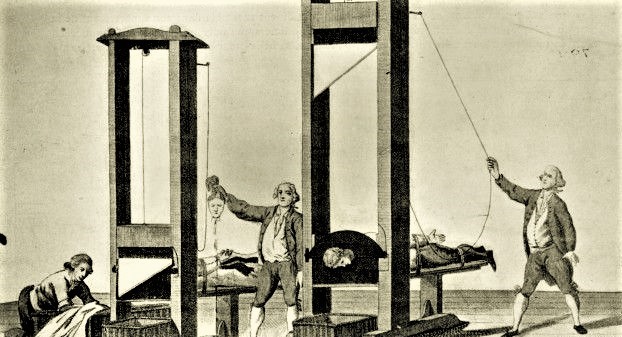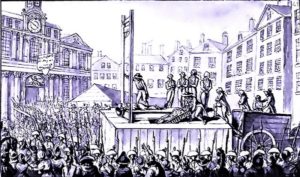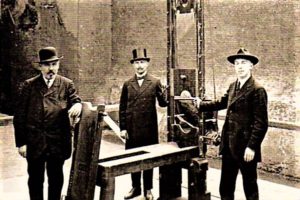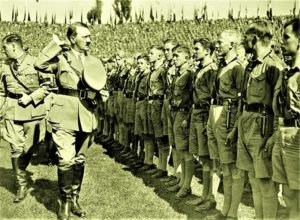
The guillotine is an equipment of capital punishment, introduced into France in 1792. The guillotine is designed to receive a quick and compassionate execution by beheading. The guillotine is probably best known for its work during the French Revolution. It struck fear into the hearts of innocent and guilty citizens across France. The guillotine design was simple yet effective. It consisted of two upright wooden beams with a crossbeam at the top, which the rope the blade was connected to was attached. Heavyweights were placed on the backside of the blade to ensure the blade picked up enough speed to cut cleanly through the neck of the guillotine’s victims.
Guillotine During the French Revolution
The guillotine is probably best known for its work during the French Revolution. It struck fear into the hearts of innocent and guilty citizens across France. It was a time of unrest and those sentenced to death rarely had trials. But beheading and even beheading machines were not new to the world at the time of the French Revolution. Beheading as a punishment happened throughout history and across the world.
It can be traced back to ancient Greek and Roman times. However, beheading wasn’t for everyone. It started out as an honorable death and was reserved for nobles and persons of importance. If you were someone of lower status, you most likely would be getting the Axe as your beheading device. But those with real prestige were decapitated by a sword. You had to be really important to get the sword. Either way, the result was the same.
Beheading History
Beheading was not just a Eurocentric punishment either. Seppuku, which is ritual decapitation by Samurai sword, was practiced in Japan from the fifteenth to the nineteenth centuries. Regardless of if you were a Samurai, Roman soldier, or English crusader decapitation was always an option as a punishment. In England, beheading gained popularity during Medieval Times.

It was used to execute rival rulers, soldiers, and traitors. But traitors were not high status, so they were not worthy of just your normal beheading. Rather, they were hauled through the streets by horse to the area of their execution, hung within inches of death, disemboweled, and then finally beheaded. Some traitors were lucky enough to have all four limbs tied to a different horse and then torn apart when the horses ran in different directions. Luckily the traitor was already dead when torn apart most of the time.
Similar Guillotine Machines
Before the Guillotine became fashionable and accelerated the beheading process, there were different machines made to accomplish this objective. A machine called the “planke” was used in Germany during the Middle Ages and England had a similar device with a sliding Axe known as the “Halifax Gibbet.” It would seem that Germany and England both beat France to the cut. Eventually, France moved into the beheading machine business.
Who Invented The Guillotine
The idea of equality of life was on the minds of everyone during the French Revolution. Dr. Guillotin just took the discussion one step further to the equality of death. He argued that it was unfair for common criminals to be tortured as capital punishment, while more noble lawbreakers were given swift and quick justice. Some wealthy felons could even tip their executioners to make sure they received a quick death. Dr. Guillotin argued that if France was going to be truly egalitarian, then those principles should extend to capital punishment as well. All criminals, regardless of class, should be beheaded, he declared!
His solution was a beheading machine that ensured everyone received a quick and compassionate death. He explained that “the mechanism falls like lightning; the head flies off; the blood spurts; the man no longer exists.” As far as punishments go, everyone is going to have the same experience. Joseph-Ignace Guillotin may have come up with the idea of using the beheading machine for executions, but he was by no means an inventor or engineer. Instead, a man by the name of Antoine Louis created and built the first beheading machine in France.
Testing and improvements of The Guillotine
Antoine Louis tested his machine on animals, and when the new contraption could cleanly sever the heads of sheep and calves he moved to human trials. First Louis tested his beheading machine on the corpses of dead women and children and was largely successful. However, with dead human male necks, the cuts never seemed clean and this prompted Louis to go through several redesign phases.

To overcome the annoying obstacles of thicker necks and denser bones of males, Louis increased the height from which the blade dropped and the blade was redesigned into a sloping, triangular shape. This did the trick and Louis’ machine could now sever the head of a fully grown male corpse with accuracy and ease. It is amazing what you can do when you’ve got a good head on your shoulders.
How this Machine named Guillotine?
The machine that Louis made was originally named after its creator. The name “Louison” or “Louisette” did not stick however, after people associated the machine with the great doctor who came up with the idea of equality for punishment and execution. Much to the lament of Dr. Joseph-Ignace Guillotin the beheading machine was renamed the guillotine. But the French people also took to calling the machine “The Widow” and the “National Razor.”
First Victim of Guillotine
The first victim of the device was Nicolas-Jaques Pelletier, who was executed in 1792. He was a criminal who had been sentenced to death for robbing and murdering Parisian citizens. A guillotine was erected in Place de Grève outside of Hôtel de Ville in Paris. Pelletier was paraded into the plaza and walked onto the platform where an enthusiastic and interested crowd awaited his execution. A fourteen-foot high wooden machine with a razor-sharp blade hanging from the top sits in the middle of the plaza.
The scoundrel Nicolas-Jaques Pelletier is walked up onto the platform and secured so his headrests at the base of the wooden tower of death. Then the executioner approaches. Instead of wielding an Axe or sword he walks empty-handed over to a lever. He pauses for a moment and then pulls. The shining blade falls like lightning and cuts straight through the criminal’s neck. Pelletier’s decapitated head falls into a wicker basket as hired hands throw sawdust onto the blood-covered wooden boards. The crowd erupts in applause.
How Guillotine Become very Popular and Fashion trend in France
The guillotine had caught on as the main form of execution for all convicted felons in the country of France. More devices were built and capital punishment by guillotine became almost as popular as egalitarianism during the French Revolution. At dinner parties, people had model guillotines in their parlors with decapitated effigies of enemies and politicians. For holidays and birthdays children received toy guillotines to decapitate their dolls or mice they caught running around the house. Poets and songwriters began to write and sing about the wonderful machine that was bringing swift justice to all who were condemned.
At all of the public executions, vendors were selling souvenirs to commemorate the time families spent together watching the executions by the famed guillotine. If you planned right or knew someone important you could even get a spot at a nearby restaurant called “Cabaret de la Guillotine.” Some people even attended the guillotine executions on a daily basis. It was reported that a group of somber taboo women called the Tricoteuses would sit on the scaffold and knit socks, hats, and scarves between beheadings. Even those being executed joined in the excitement. There were accounts of people walking to their death making sarcastic jokes and dancing their way up the steps to the guillotine.

Not only were the executions by guillotine popular and widely attended, but the guillotine operators were revered as celebrities. During the French Revolution guillotine operators were judged by fans on how quickly and precisely they could behead their victims. The more beheadings the more admired the executioner was in the hearts of the onlookers. The guillotine executioner profession became a family affair such as with the Sanson family. Fathers and sons served as state executioners for multiple generations and were responsible for decapitating King Louis XVI and Marie Antoinette. Between the 1790s and 1840s, the family was responsible for decapitating thousands of individuals using the guillotine and could go almost as quick as a beheading a minute. It was said that the names of executioners were chanted for all to hear and the clothing of executioners inspired the latest fashion trends across France.
Problem’s and Rumor’s
It was rumored over the centuries that when the head was cut off a victim it was still conscious and could even move and speak. There is some truth to these claims, but not much. The brain uses around twenty percent of all oxygen taken in by a human body. Once oxygen stops being supplied to the brain, such as when the head is separated from the heart and lungs, the brain shuts down. However, there is a small window of time where the oxygen and blood that is present in the brain can still be used. The rumors of decapitated heads still being conscious gained public attention when in 1793 an executioner’s assistant slapped the face of the decapitated head of Charlotte Corday.
She was charged and sentenced to execution for the murder of her husband. The onlookers claimed to see her cheeks flush and turn red with anger. This story led doctors and enthusiasts to ask decapitated heads to blink, speak, or show signs of consciousness. Spoiler alert, no severed heads showed any signs of consciousness. The experiments with decapitated heads were put to a stop in the twentieth century, however, studies on rats found that brain activity in a decapitated head may continue for up to four seconds after the head is separated from the body.
The Guillotine during the Nazi regime
Much to the dismay of guillotine enthusiasts, all things must come to an end. Slowly capital punishment dwindled during the twentieth century. However, there was a brief resurgence of the guillotine during the Nazi regime. During the 1930s twenty guillotines were ordered to be placed in cities across Germany. According to Nazi records the guillotines were used to execute over sixteen thousand people between 1933 and 1945. After World War II the guillotine was still used in France until 1977 for capital punishment. The last person to be executed by the guillotine was a convicted murderer named Hamida Djandoubi. A few years later in 1981,

France abolished capital punishment altogether. Before his death, Guillotin became incredibly distraught with how the device he had envisioned and helped create became a symbol of death and terror across Europe. Guillotin tried to dissociate his name from the beheading machine, and his family petitioned the French government to change its name, but neither was successful. There are many forms of torture and punishment more painful than the guillotine, but few can claim such swift and numerous deaths as the “National Razor.”